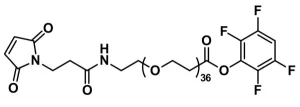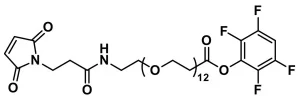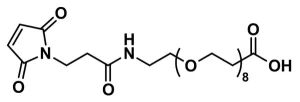Bis-MAL-Lysine-dPEG®4-TFP ester, product number QBD-10631, is a unique crosslinker from Vector Laboratories, Inc. The alpha (α) and epsilon (ε) amines of lysine are functionalized with sulfhydryl-reactive maleimidopropyl groups. The carboxylic acid tail of lysine is conjugated to a single molecular weight, discrete polyethylene glycol (dPEG®) spacer containing an amine-reactive 2,3,5,6-tetrafluorophenyl (TFP) ester. The distance from the carbonyl carbon of the dPEG® spacer to the reactive site of the α-amine-conjugated maleimide group is 25 atoms (18.773 Å) long. The distance from the carbonyl carbon of the dPEG® spacer to the reactive site of the ε-amine-conjugated maleimide group is 29 atoms (26.105 Å) long.
TFP esters react with primary and secondary amines to form stable amide bonds like the more widely used N-hydroxysuccinimidyl (NHS) esters. However, TFP esters demonstrate superior hydrolytic stability and higher reactivity with amines than NHS esters. The optimum pH for this reaction is 7.5 – 8.0. Thus, the product functions as a heterobifunctional crosslinker.
By design, the two maleimide groups of Bis-MAL-Lysine-dPEG®4-TFP ester can be used to bridge disulfides. For example, this capability may be useful in antibodies following reduction of the disulfide groups. Moreover, the two maleimide groups can be used to dimerize small molecules or peptides, each of which possesses a single free thiol group. At pH 6.5 – 7.5, maleimide groups react chemoselectively with sulfhydryls. However, above pH 7.5, chemoselectivity is lost, as maleimide groups also will react with free amines.
Possible uses for Bis-MAL-Lysine-dPEG®4-TFP ester include the construction of antibody-drug conjugates (ADCs); immobilization of antibodies or antibody fragments on solid supports; and dimerization of sulfhydryl-containing peptides followed by crosslinking to an amine-modified surface.
| Unit Size | 100mg, 1000mg |
|---|---|
| Molecular Weight | 843.77; single compound |
| Chemical formula | C₃₇H₄₅F₄N₅O₁₃ |
| CAS | 1426164-53-5 |
| Purity | > 98% |
| Spacers | dPEG® Spacers are 25 and 29 atoms and 18.8 and 26.1 Å, , avg., resp. |
| Shipping | Ambient |
| Typical solubility properties (for additional information contact Customer Support) | Methylene chloride, Acetonitrile, DMAC or DMSO. |
| Storage and handling | -20°C; Always let come to room temperature before opening; be careful to limit exposure to moisture and restore under an inert atmosphere; stock solutions can be prepared with dry solvent and kept for several days (freeze when not in use). dPEG® pegylation compounds are generally hygroscopic and should be treated as such. This will be less noticeable with liquids, but the solids will become tacky and difficult to manipulate, if care is not taken to minimize air exposure. |
Greg T. Hermanson, Bioconjugate Techniques, 3rd Edition, Elsevier, Waltham, MA 02451, 2013, ISBN 978-0-12-382239-0; See Chapter 18, Discrete PEG Reagents, pp. 787-821, for a full overview of the dPEG® products.
Mono-PEGylated Dimeric Exendin-4 as High Receptor Binding and Long-Acting Conjugates for Type 2 Anti-Diabetes Therapeutics.Tae Hyung Kim, Hai Hua Jiang, Seulki Lee, Yu Seok Youn, Chan Woong Park,Youngro Byun, Xiaoyuan Chen, and Kang Choon Lee, Bioconjugate Chem., 2011, 22 (4), pp 625–632 March 14, 2011. DOI: 10.1021/bc100404x.
Applicable patents and legal notices are available at legal notices.




Stay in the Loop. Join Our Online Community
Products
Ordering
About Us
Application
Resources

©Vector Laboratories, Inc. 2025 All Rights Reserved.
To provide the best experiences, we use technologies like cookies to store and/or access device information. Consenting to these technologies will allow us to process data such as browsing behavior or unique IDs on this site. Not consenting or withdrawing consent, may adversely affect certain features and functions. Privacy Statement
How do I Request a Quote?
To request a quote for products: